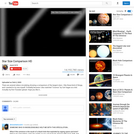
See a line up of moons, planets, and stars to give a visual of how Earth compares in size to other bodies in the universe.
- Subject:
- Astronomy
- Physical Science
- Material Type:
- Lecture
- Author:
- morn1415
- Date Added:
- 11/23/2016

See a line up of moons, planets, and stars to give a visual of how Earth compares in size to other bodies in the universe.
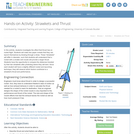
In this activity, students investigate the effect that thrust has on rocket flight. Students will make two paper rockets that they can launch themselves by blowing through a straw. These "strawkets" will differ in diameter, such that students will understand that a rocket with a smaller exit nozzle will provide a larger thrust. Students have the opportunity to compare the distances traveled by their two strawkets after predicting where they will land. Since each student will have a slightly different rocket and launching technique, they will observe which factors contribute to a strawket's thrust and performance.
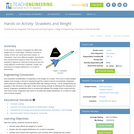
In this activity, students investigate the effect that weight has on rocket flight. Students construct a variety of their own straw-launched rockets, or "strawkets," that have different weights. Specifically, they observe what happens when the weight of a strawket is altered by reducing its physical size and using different construction materials. Finally, the importance of weight distribution in a rocket is determined.
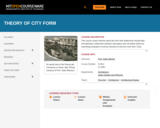
This course covers theories about the form that settlements should take and attempts a distinction between descriptive and normative theory by examining examples of various theories of city form over time. Case studies will highlight the origins of the modern city and theories about its emerging form, including the transformation of the nineteenth-century city and its organization. Through examples and historical context, current issues of city form in relation to city-making, social structure, and physical design will also be discussed and analyzed.

Nigel Poor is a photographer who spends time documenting everyday existence, exploring the meaning of the traces of ourselves that we leave behind. She focuses on ordinary objects and materials, researching what makes an object “worthy of preservation,” in her words. This KQED Art School video was created in collaboration with SFMOMA, who commissioned art-making activity ideas from Nigel Poor for their Open Studio project.

Learning about spaceflight couldn't be more fun with these Shuttle inspired toys.

This subject examines the unique culture that developed in the United States after World War II. The dawn of the nuclear age and the ensuing Cold War fundamentally altered American politics and social life. It also led to a flowering of technological experimentation and rapid innovation in the sciences. Over the course of the term, students will explore how Americans responded to these changes, and how those responses continue to shape life in the US today.
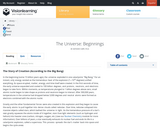
The Story of Creation (according to the Big Bang). A mythical trek through the last 15 billion years.
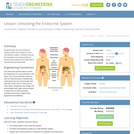
Students learn how the endocrine system works and compare it to the mail delivery system. Students discuss the importance of communication in human body systems and relate that to engineering and astronauts.

This resource is a video abstract of a research paper created by Research Square on behalf of its authors. It provides a synopsis that's easy to understand, and can be used to introduce the topics it covers to students, researchers, and the general public. The video's transcript is also provided in full, with a portion provided below for preview:
"With an increasing number of spaceflights, microbial colonization of spacecrafts and assembly facilities is a concern. Planetary protection research focuses on developing technology for cleaning and sterilization, and clean rooms are the final step before spacecraft launch into space. But with their stringent air filtration and cleaning, Space Assembly Facility (SAF) rooms become a selective environment for microorganisms that can tolerate extreme cleaning methods. Because these microorganisms are likely low-abundance, current identification methods can struggle to characterize and profile SAF-residing microbes. A new study presents a comprehensive metagenomic framework to characterize microorganisms relevant for planetary protection. Researchers sequenced and analyzed 51 metagenomic samples from SAF clean rooms to identify microbes that could potentially survive spaceflight..."
The rest of the transcript, along with a link to the research itself, is available on the resource itself.

Susie Thiel, University of Kentucky Director of Dance, talks about the elements of dance: time, force, and space, and how they affect dance creation.
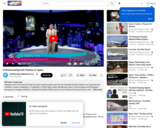
In celebration of World Space Week, NASA talks about their human space exploration programs.
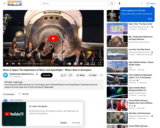
NASA Astronaut Col. Fred Gregory and Dr. Michael Nickens from George Mason University discuss the integral role music plays here on Earth and beyond.
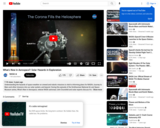
Understanding the hazards of space weather on crewed and robotic missions is vital to informing plans for NASA's Journey to Mars and other missions into our solar system, and beyond.
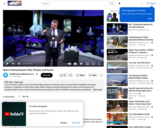
Badri Younes, discusses the evolution of NASA's communication capabilities, including the exciting future of laser communication.

Astronaut Serena Auñón-Chancellor (M.D.) discusses the importance of practicing medical science in space and describes what life on the International Space Station is like.
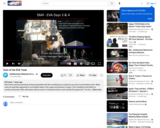
This presentation looks at the past, present, and future of EVA (extra-vehicular activity) tools.
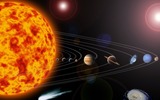
In this lesson, students will hone their investigative skills and form an opinion based on the credible evidence that they uncover. After learning about the decision to deem Pluto a "dwarf planet," students will have time for individual investigation. After using their background knowledge to choose credible sources, they will analyze the information they gather to form their own opinion, which they will support in a video response to a prompt on Flipgrid.
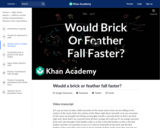
What would fall faster on the moon, a brick or a feather? Created by Sal Khan.
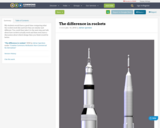
My students would have a good time comparing what the rockets look like and how they are similar and different. You could then take it to the next step and talk about how rockets actually work and then even have a discussion about which design then you think would be better.